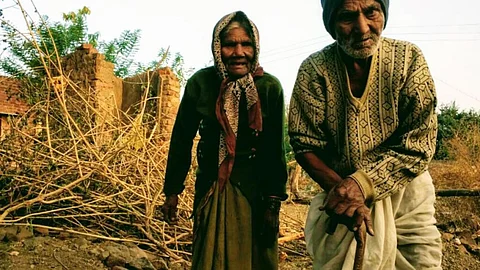
- Topics
- Feature
- Opportunities & Events
- Data
- Hindi Portal
- Topics
- Feature
- Opportunities & Events
- Data
- Hindi Portal

“Ikde Aa. Mi Tula Dakhavato.”
“Come here. I will show you” ‘Ajji’ (grandma) grabbed my hand firmly as she led me towards her humble dwelling. Her house was in shambles and a ghost of a toilet superstructure adjoined it.
Dagadu Babaji Rokade and his frail elderly wife, belonging to a remote village in Marathwada’s Osmanabad District, lost their only son eight years ago. The couple lives on meagre means without any sustainable source of income. Their half-a-toilet stares in the backdrop. Ajji is now old and finds it unbearable to wait till early morning just to relieve herself. For people like ajji, a toilet is a luxury commodity and not another 'basic necessity'.
And this is the story of every 1 in 3 women in the developing world, who live without access to safe sanitation as per a WaterAid estimate. Around the corner of the village is the house of Balasaheb Kshirsagar* who laments that he received only Rs 3000 out of his first instalment of Rs.4000 from the Swachh Bharat Mission subsidy. Apparently, the remainder of the subsidy never arrived and neither did the government officials who convinced him to start construction. With a 15-year-old adolescent girl at home to take care of, he feels the pressing need for a toilet now more than ever.
Figures of the All India Baseline Survey (2012-13) conducted by Ministry of Drinking Water & Sanitation suggest that 1.39 crore of the total 7.41 crore individual household toilets in India were defunct. Even the urban landscape doesn’t spare women from this fate with virtually nonexistent safe and clean sanitation facilities along our highways and public places. Fortunately, the ‘Right to Pee’ campaign nudged a few state governments like Maharashtra to open up 400 Jansuvidha Kendra Toilets along the highways. Nevertheless, there is still a long way to go unless taken up on a Central level.
Rashmi*, 24, an expectant mother from Begada village near Tuljapur, blushes when we talk about the baby. But her expression changes to that of disdain when she confides, “I feel insecure and ashamed while going outside to the fields to defecate. I don’t like it when others, especially men stare at my baby bump. Had there been a toilet at home, it would have been more comfortable.”
But this story just doesn’t stop at inconvenience. It picks a few companions enroute, like sexual harassment, shame, disgust, maternal mortality, lost hours of productivity and the vicious cycle of health expenditures, poverty and malnutrition. A study conducted by the DFID funded SHARE Research programme on 667 pregnant women in rural Odisha found that of the 58.2 percent women who practiced open defecation, 25.7 percent experienced Adverse Pregnancy Outcomes (APO’s) such as spontaneous abortions & stillbirths--including 19.4 percent preterm births and 14.2% births with low birth weight. (Cumming,O et.al, 2015)
A testimonial to these results is India's abysmal Maternal Mortality Rate--167 for 100,000 live births (NIITI Aayog)--with neighbours like Bhutan doing still better at 148. Research has also shown good evidence that poor sanitation promotes Hookworm Infestation which is a risk factor for maternal anaemia and in turn directly linked to APO’s. On the other hand, Puerperal Sepsis - a condition emanating from poor hygiene contributes to 8 percent of all global maternal deaths. Imagine the scale of this impending global health crisis with 1.25 billion women and girls not being able to access improved sanitation. (WHO, UNICEF 2012)
Reportedly, 23 percent adolescent girls who drop out of school do so because of shortage of clean toilet facilities at school. (Times of India, 2017)
What is more terrifying is the fact that we are still analysing sanitation through the lens of cost-benefit analyses (sanitation costing 5.2 percent of total GDP). Such analyses fail to consider, for instance, that a girl who drops out of school loses out on an education, a productive livelihood, an empowered opinion and better life choices. Women around the world today are fighting for their rights to equality - from breaking glass ceilings to an equal wage rate. Yet there are so many women who still don't enjoy this very basic right - the right to equitable sanitation and hygiene.
References:
https://www.wateraid.org/au/news/news/on-international-womens-day-wateraid-is-working-to-inspire-change-on-water-and-sanitation WHO, UNICEF(2012)
Countdown to2015: Maternal, Newborn and Child Survival; Building a Future for Women and Children.
WHO, Geneva. Padhi BK, Baker KK, Dutta A, Cumming O, Freeman MC, Satpathy R, et al. (2015)
Risk of Adverse Pregnancy Outcomes among Women Practicing Poor Sanitation in Rural India: A Population-Based Prospective Cohort Study. PLoS Med 12(7): e1001851.
doi:10.1371/journal.pmed.1001851 http://www.indexmundi.com/g/r.aspx?v=2223
http://niti.gov.in/content/maternal-mortality-ratio-mmr-100000-live-births
http://databank.worldbank.org/data/reports.aspx?source=2&series=SH.STA.MMRT&country=
https://www.thehindu.com/data/What-numbers-tell-us-about-Open-Defecation-in-India/article15422326.ece
http://timesofindia.indiatimes.com/city/udaipur/23-girls-drop-out-due-to-lack-of-toilets-in-school-of-the-country-reveals-study/articleshow/56490444.cms
This article was first published on Medium, and has been republished here with the consent of the author. Views and facts presented in this article do not reflect those of India Water Portal.